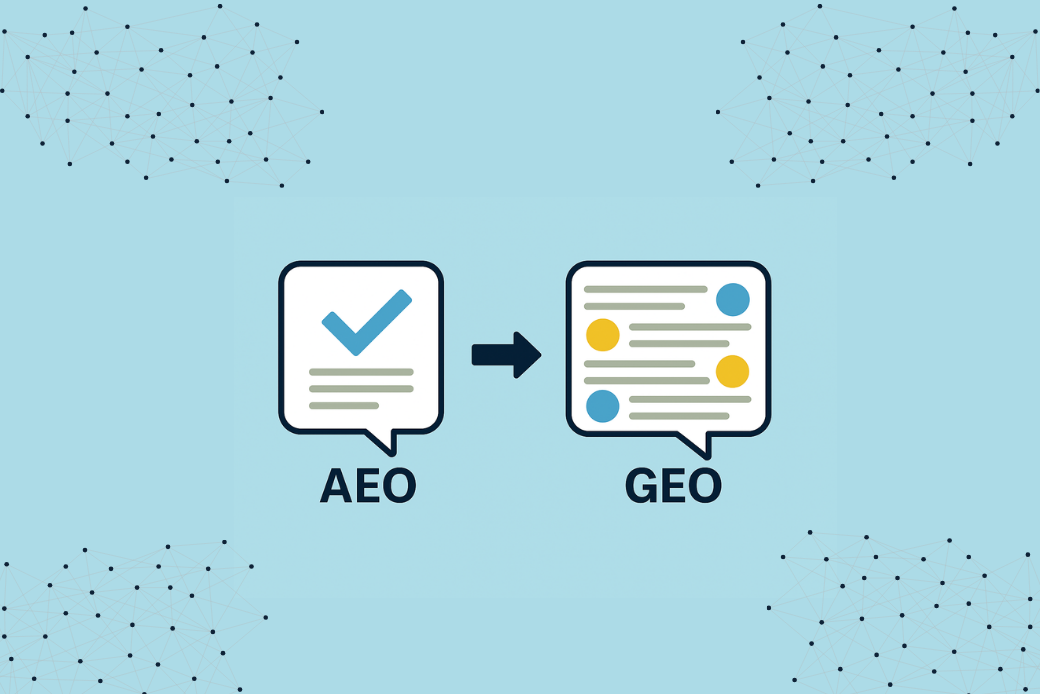
AEO vs. GEO: Understanding the Shift from Answer Optimization to Generative Visibility

AEO vs. GEO: What’s the Difference and Why It Matters
In our previous article, about staying visible with AI search , we explored how AI-generated answers are reshaping discoverability and reducing clicks. If you're interested in AI search and thought, “Wait, what’s the difference between all these new optimization terms I’m seeing?”, you’re not alone. Two in particular are getting used frequently: AEO and GEO. They sound similar, they both deal with AI, and they both promise to help your brand stay visible in this new world of machine-made answers, but they're far from the same.
Let’s break down the differences and clear the confusion.
From Search Engines to Answer Engines
A few years ago, SEO specialists started noticing a new trend. People were no longer searching in the traditional sense; they were asking and expecting a concise and accurate answer. Voice assistants and smart speakers kicked off the trend, and suddenly Answer Engine Optimization (AEO) became the next big thing.
AEO focused on helping brands become the single, spoken answer. Think: “Hey Google, where can I buy performance tires near me?”, “What size cabin air filter fits a 2020 Ford F-150?”, or “Which running shoes are best for flat feet?” If your website provided the clearest, most structured response, you could win that coveted top answer without users ever scrolling.
Today, AEO has evolved beyond voice search. It’s increasingly used to measure how often a brand is featured or cited in the AI Insights sections of search engines like Google, which deliver direct answers above the traditional link lists.
Goal: Be the one definitive answer
Tactics: Schema markup, FAQs, concise question-based content
Platforms: Google, Bing, Alexa, Siri
Example: “What’s the best lightweight jacket for spring?” → Your apparel brand appears as the direct spoken or listed answer
AEO marked the start of a shift toward conversational search. Then generative AI came along and rewrote the rules again.
From Answers to Conversations: Enter GEO
Generative Engine Optimization (GEO) builds on AEO’s foundation and extends it into the world of generative AI. Instead of optimizing for a single search result or featured snippet, GEO focuses on how your brand is represented inside AI-generated responses and conversations.
When someone asks, “Which ecommerce platform works best for retailers that also sell wholesale?”, the AI is not looking for one short reply. It is building a complete narrative, pulling from multiple sources, and deciding which companies, experts, and examples to include. GEO ensures your brand becomes part of that story.
AEO remains critical for visibility in traditional and hybrid search experiences. GEO builds on those same principles but applies them to a broader, more contextual environment where large language models generate answers dynamically.
In short, AEO was about being the answer. GEO is about being part of the conversation and the source of truth. Both are still important as customers expand the ways they discover new information.
AEO vs. GEO: The Quick Breakdown
Category | AEO | GEO |
Focus | Voice assistants and featured snippets | Generative AI chat and AI search |
User Intent | “Give me the answer” | “Help me figure it out” |
Optimization Target | Search algorithms | Language models |
Tactics | Schema markup, FAQs, concise structure | Entity clarity, topic depth, brand integration |
Result | One-shot factual response | Multi-turn AI dialogue with citations and context |
Other Terms You’ll See in the AI Optimization Landscape
The world of AI-driven visibility moves quickly, and the acronyms are multiplying. Here are a few that help complete the picture:
SEO (Search Engine Optimization): The classic. Still relevant, but now competing with AI systems that summarize results instead of listing them.
AEO (Answer Engine Optimization): The early step toward conversational search. Designed to help brands become the single spoken or featured answer.
GEO (Generative Engine Optimization): The modern approach to ensuring AI models understand, summarize, and credit your content accurately.
GXO (Generative Experience Optimization): A newer spin on GEO that focuses on optimizing the user experience within AI-driven interfaces, such as guided shopping or conversational recommendations.
EEAT (Experience, Expertise, Authoritativeness, Trust): Google’s framework for judging credibility. Still relevant in AI training data, especially for industries where accuracy and trust matter most.
RAI (Responsible AI): The practice of keeping AI content creation ethical, transparent, and safe. It’s becoming a growing part of how brands manage data and trust.
RAG (Retrieval-Augmented Generation): The process AI tools use to research and generate responses. Models retrieve relevant information from external sources, then synthesize it into an answer. Understanding how RAG works can help brands create content that is easier for AI systems to find, understand, and cite.
AIOS (AI Optimization Strategy): A catch-all term for integrating SEO, AEO, and GEO into one cohesive plan that connects visibility, authority, and content structure.
Let us clear things up further
The landscape is evolving, but the fundamentals remain the same: clarity, authority, and consistency are required. Whether your audience finds you through a search bar, a chatbot, or an AI-powered assistant, your content needs to be understandable, quotable, and worth citing.
At Avatria, we help our customers create commerce, content, and analytics strategies that connect with both humans and the AI systems shaping the future of search.
Ready to strengthen your AI visibility? Contact us below and we’ll help you measure what matters and stay visible where it counts.
